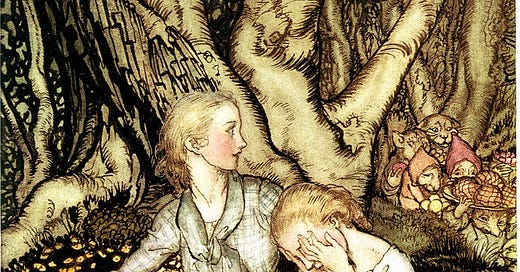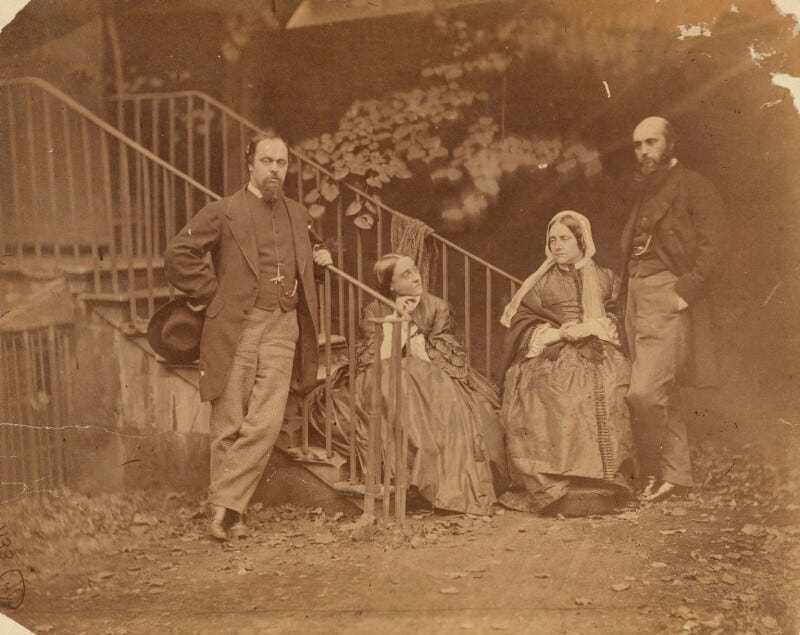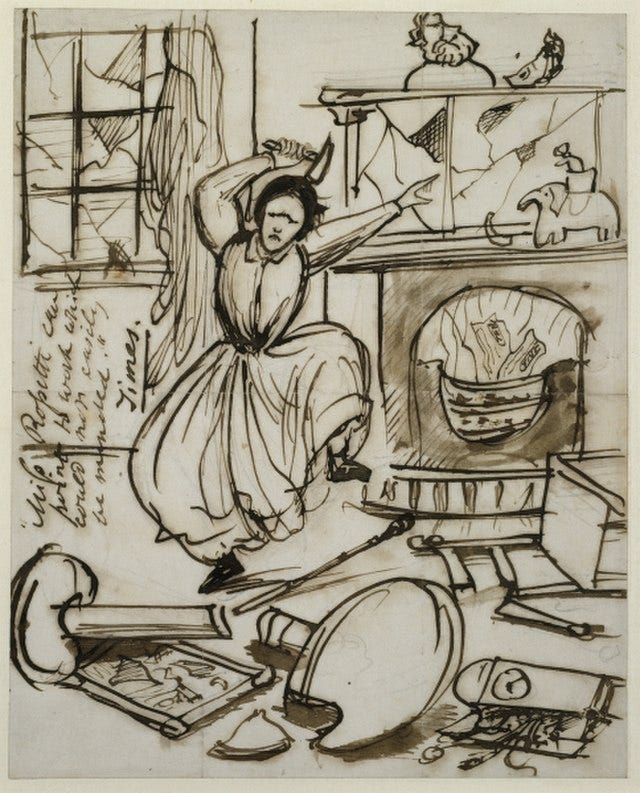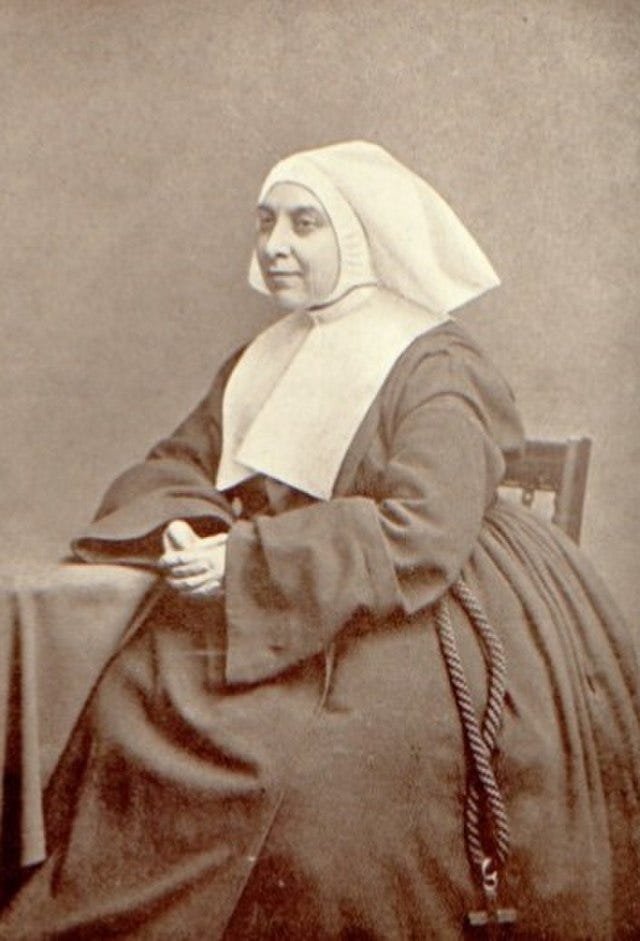Before I got into this sister obsession, when I thought of the Rossettis (not often, but sometimes) I thought painting and poetry. I knew vaguely about Dante Gabriel, the painter, and Christina, the poet. I knew about big pre-Raphaelite canvases with women with bold jawlines and red hair, and a brilliant narrative poem I’d read growing up called Goblin Market. We had a copy in the house with wonderful illustrations by Arthur Rackham like the one above. Yup. That was about it.
But as my sister project blossomed, I came to re-read Goblin Market, the story of two sisters Laura and Lizzie who live in a fairy-tale world. When Laura is tempted by the gloriously-described, fruity, succulent temptations offered by a range of truly hideous goblins…
One had a cat’s face, / One a whisked tail, / One tramped at a rat’s pace, / One crawled like a snail,
… its up to Lizzie to save her.
While the poem can be read on many levels (as any good poem surely should) I love it mainly for the drama in the story itself (which I’m working hard not to spoil for anyone who hasn't read it) and the lushness of the language. But it’s the final lines that speak to me as a read it again now, thinking about the qualities of sisterhood:
For there is no friend like a sister / In calm or stormy weather; / To cheer one on the tedious way, / To fetch one if one goes astray, / To lift one if one totters down, / To strengthen whilst one stands.
Surely Christina Rossetti must have had a sister? I’m no great fan of interpretations of fiction that lean into the writer’s biography, but in this case, with these heartfelt words, I felt I had to take a look. And yes, Christina did have a sister, a sister to whom she dedicated this splendid poem, a sister with whom she was very close, and a sister who was also a writer in her own right. Here they are with their famous brothers, from left to right, Dante Gabrielle, Christina, Maria, and William:
Maria was born in February, 1827, Gabriel in May, 1828, William in September, 1829, and Christina in December, 1830. Blimey. As the mother of three kids who were all under four at one point, I’m exhausted just thinking about how close these siblings were in age! Happily, despite living wildly different lives, and diverse views on religion, they remained a close knit group. The sisters were particularly close, supporting each other through many periods of ill-health, as well as their literary endeavors. In her youth, Christina was an active writer, publishing her first poetry collection aged only sixteen, but frequently so unwell that many of her early manuscripts are in Maria’s handwriting.1
Neither sister married, although in her letters (available to read online here) Christina writes about putting money aside from her earnings from her poetry to bolster Maria’s dowry. Christina was engaged for a time to James Collinson, a painter and part of the Pre-Raphelite Brotherhood founded by her brothers, but religious differences caused them to separate. In her mid-thirties she rejected a proposal from a scholar and family friend, Charles Bagot Cayley. Maria and Christina lived far more quietly and piously than their brothers, but Christina’s poetry - from the hedonistic ripe fruit of Goblin Market onwards, suggest that living quietly did not make her naive. Browsing through the doorstopper of a book that is the Penguin Classic edition of Rossettis complete poems, I came across many great poems including Husband and Wife which you can read here - a short read with a big bite.
But back to the sisters. This drawing from 1862, which ought to make all writers everywhere who know the misery of reading bad reviews feel so much better, suggests a wild side to Christina Rossetti, but her letters (edited by brother William) paint a much more considered woman, with plenty of sisterly love. Christina frequently writes to family and friends, passing on Maria’s love and affection so it’s easy to imagine them in the same room together. She spends much time on Maria and her own illnesses and it’s hard reading at some points, given the blunt instrument that was Victorian medicine. There are ‘sulphureous preparations’2 and countless trips to take the air at Eastbourne, as well as diverse colds and coughs interrupting their social calendar.
Although both sisters were published, Maria was a writer of a very different stamp to her sister. Jan Marsh gives Maria short shrift in her book, Pre-Raphaelite Sisterhood, declaring that “even the earnest Maria was an author with a textbook of idiomatic Italian issued in 1867”3 but Christina in her letters describes A Shadow of Dante (1871), a work on non-fiction, as her sister’s “masterpiece”4 that she wishes could be translated into Italian.
When, after two years as a novice, Maria became a nun in 1875, her sister was pleased to report that she ‘looks more imposing in the dignified “professor'“ cap, than she did as a novice”5 but that’s the only instance of sisterly snark I’ve managed to find. Over the next nearly two years, Maria fell ill and lost what reads like a pretty difficult battle with cancer that included two surgeries. Christina’s letters record her decline and this one to Gabriel speaks through the years and surely must resonate with anyone who has lost a beloved family member:
“I am sorry to keep distressing you over & over again, but we fear dear Maria is really losing ground & that rapidly: you who love her ought to know this. No third operation can take place, at least not at present: this is in itself a comfort, the fluid not have collected to any very great extent. Any day I fear I may have a still sadder letter to write to you; but here I may be mistaken, as sometimes strength, even when dwindled to no more than weakness, does hold out wonderfully.”6
Maria died aged 49 on November 24th, 1876, Christina on December 29th, 1894, just one day shy of her 64th birthday.
The impact of this sisterly relationship on Christina Rossetti’s poetry is apparent in the Goblin Market itself, as well as in reports of Maria acting as her sister’s amanuensis. But it may be even greater. In 1888, Christina herself wrote of Maria’s important influence on her work:
“Perhaps the nearest approach to a ‘method’ I can lay claim to was a distinct aim at conciseness: after a while I received a hint from my sister that my love of conciseness tended to make my writing obscure, and I then endeavoured to avoid obscurity as well as diffusiveness.”7
But this one is my favorite nugget. Apparently their brother Gabriel told the story that on their mother’s birthday in 1842, when the girls would have been only 12 and 15, Maria declared the verses Christina presented as a gift were so good that she would surely “be the poet in the family”.8 She wasn’t wrong. And maybe even by saying so, she had a hand in making it happen.
Christina Rossetti, The Complete Poems, Penguin, 2001
Letter 515 The Letters of Christina Rossetti
Jan Marsh, Pre-Raphaelite Sisterhood, p258
Letter 772
Letter 638
Letter 683
Jan Marsh, Christina Rossetti’s Vocation: The Importance of Goblin Market, Victorian Poetry (JSTOR)
ibid









